The History of Ruthenian Empire covers six periods since the existence and recordings of Selloi people, the First period, marked by a numerous tribes and the aparition of St. Hellena as unifying the tribes into one, St. Helena led the Selloi people and created the first major tribes also taught the first Orthodox canons, promising the promised land and other essential factors in the spiritual history of the Hellenes, the first Selloi colonists founded the city of Beretea and Hispales, and after the fall of Hispales by other Selloi chieftains marked the existence of Selloi culture, this period is called Archaic or Early Period of the Ruthene history.
The Second era is knowed as the Dark Ages or the Period of Migrations, when numerous foreign tribes invaded the rothoi peninsula and the Korimis, and Sarbians captured almost every Selloi city-state, founding principates and merged with the Selloi society. during the Migration ages two great kingdos was formed: Kormenia and Slavinia when competed each other for the dominance of the peninsula. in this period a strong sense of spirituality and protection of values Hellenic customs, thanks to Korimi traditions and the church, the Orthodox Church grew and spread throughout the region, unifying all other tribes under one flag and one religion, the dominance ended with the Pacta Conventa between Phillipos of Kormenia and the Slavian nobility.
The reign of Kormenia installed and establishes local customs, art, religion and Selloi trade between the Korimi people achieving a peaceful merger between the two peoples,Mauryans established their own principality recognized after 600 years, known as Arcadiaand Sarbs settled merging its people and its culture with that of the Korimis in Kormenia.
After almost a millenium the Orthodox Church grew and spread throughout the region, unifying all other tribes under one flag and one religion, the kingdom of Kormenia for a millennium gave both Selloi and Slavians one Kingdom and one religion where art, culture and tradition of both were united as one people and one idea created by the ecclesiastical protection of self and pride in your ancestry, Kormenia established later as a Empire in 1902 after a succession crisis between the Kormenian nobility, be the dominant empire of the Selloi for 500 years.
The late Kormenian period ended after a long Civil war between the Kormenian nobles and, a long period of misrule, decadence and a debilitating war against the Parsian invaders brought down the Kormenian Empire in 2588 after the fall of its capital enslaving the selloi and all the kormenian citizens, after the fall of Beretea, the Parsians founded the Parsian Empire as the succesor of Kormenia, beginning the Age of Enslavement or the Parsian Period.
The Age of Enslavement lasts almost 700 years, until the interregnum, when the Parsian sovereignty weakens and agrees to use the Selloi out of trouble, the Parsian weakness comes with the strength of the Selloi that slowly recover lost liberties and customs, awakening in them the spirit of liberation and unification of a flag in front their oppressors, customs and the memory of his heritage, born of a revolutionary movement called the church and for many riots release Selloi town called "Enosis" brand the great war of the Ruthene Revolution, which lasted almost 30 years and ends with the Battle of Ostambal, where the Parsian Empire is abolished and the new Selloi state is created from the ashes, based on the customs and your pride as selloi and the memory of St. Hellena, creating the Ruthenian Empire, being Ruthene, the imperial and ancestral unification of all those peoples united under one god, one empire, one emperor, the Basileus chosen for the church.
Timeline[]

- Dates are approximate, consult particular article for details
| Years | Period | Important Events of Ruthenian History |
|---|---|---|
| 20-50 AM | Archaic | Establishment of Selloi city States in Rothoi Peninsula |
| 150-200 AM | Archaic | Hispalis-Sabarian Wars |
| 250-340 AM | Archaic | Aparition of Hellena, Consolidation of Hispales |
| 324 AM | Archaic | Foundation of Beretea |
| 350 AM | Archaic | Evangelization of Selloi |
| 480 AM | Archaic | Fall of Hispales |
| 510 - 625 AM | Migration | Sarbian Migrations |
| 650 AM | Migration | Establishment of Rothoi League |
| 825 AM | Migration | Founded the Principality of Slavinia in the western part of the Peninsula |
| 800-973 AM | Migration | Korimi conquest of the Rothinoi Peninsula |
| 878 AM | Migration | Evangelization of Sarbians by St. Theodoros |
| 895 AM | Migration | Klassr founded the Principality of Kormenia |
| 952 AM | Migration | Recognition of Principality of Carantia as a state |
| 1000 AM | Migration | Council of Beretea, St. Stephanos is crowned as the first king of Kormenia |
| 1050 AM | Early | Proclamation of Sacred Mountain of Mount Agios |
| 1097 AM | Early | Battle of Orotal Mountain, Union of Kormenia and Slavinia |
| 1218 AM | Early | Reign of King Apolonios, Kormenia's most important religious and political institutions are attributed to him |
| 1542 AM | Early | Invasion of Comans |
| 1700-1737 AM | Early | Conflicts between Carantia and Kormenia |
| 1901 AM | Early | Death of Menelaos IV, last of Almodian dynasty, Succession crisis |
| 1913 AM | Late | Battle of Dadgori, coronation of Emmanuel I as Emperor of Kormenia |
| 1994 AM | Late | Aparition of Sultanate of Parsia |
| 2030-2080 AM | Late | Sagovian Reforms of Pavlos III |
| 2100 AM | Late | Privilegium pro Slavis |
| 2215 AM | Late | Declaration of Great War against Parsians |
| 2291 AM | Late | Battle of Kollonia, death of Demetrios II |
| 2365 AM | Late | Kormenian Civil war, Andronikos VII declared vassalage of Parsia |
| 2450 AM | Late | Siege of Beretea, Antonios III pay a strong tribute on an annual basis. |
| 2588 AM | Late | Fall of Beretea, Establishment of Parsian Empire |
| 2590 AM | Enslavement | Confirmation of Autonomy of Mount Agios by Mesud II |
| 2591 AM | Enslavement | Creation of Caliphate in Parsia |
| 2800 AM | Enslavement | Creation of Kingdom of Mauria as tributary state |
| 3171-3174 AM | Enslavement | Interregnum |
| 3190 AM | Enslavement | Imperial Reforms of Mesud III |
| 3210-3216 AM | Enslavement | The Enosis, Collapse of Parsia |
| 3216 AM | Ruthene | Creation of Ruthenian Empire |
| 3220 AM | Ruthene | Ruthene-Maurian War |
| 3221 AM | Ruthene | Creation of Thracia |
Archaic Period[]
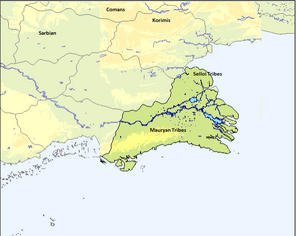
First Tribes
The Archaic period in Ruthenia (1 AM – 480 AM) was a period of ancient Ruthene history that followed the Ruthene Prehistory. This period saw the rise of the Doukelias (city-states), the founding of colonies, the aparition of Orthodox Church, as well as the first inklings of classical philosophy, theatre in the form of tragedies and the development of colonies and trades between the cities of Hispales and Sarabia where born a rivalry between the two cities in cultural and economic terms, this rivalry explodes into war known as Hispalis-Sabarian Wars.
In this period was born the written poetry, which appeared with the reintroduction of the written language, lost during the Prehistory. The term archaic covers these cultural aspects as well.
The termini of the Archaic period are defined as the "structural revolution", meaning a sudden upsurge of population and material goods that occurred c. 750 BC, and the "intellectual revolution" of classical Ruthene. The end of archaism is conventionally marked by the apparition of St. Hellena and the destruction of Hispales in 480AM
The sharp rise in population at the start of the Archaic period brought with it the settlement of new towns and the expansion of the older population centres. The Archaic period is also characterized by the spread of colonization along the Marmoran and Black Sea coasts that began about 500 years earlier. The reason for this phenomenon is described by authors as stenochoria, or "the lack of land", but in practice it was caused by a great number of reasons, such as rivalry between political groups, a desire for adventure, expatriation, the search for trade opportunities, founding numerous "doukelias" or comercial city states, these doukelias was the centre of Selloi and Early Mauryan culture and civilization.
The Selloi developed numerous arts and created works of literature, arts and developed trade, creating a currency system based on the economic might of each doukelia, developed a primitive system of medicine based on herbs and early writers of great texts were Selloi, presumably that cultural advancement and progress in these arts that Selloi became the dominant language in the region, despite the strong Mauryan influence in many aspects, especially in trades between different tribes.
From the beginning of the 4th century, many changes in the social structure and government of Ruthenia were formalized in order to administer to the growing needs of the Doukelias. Among these changes was the formalization of certain aspects of the Hispalis democracy, and as Hispales consolidated itself into a formal city-state, political tensions grew within it.
Towards the end of the Archaic period, the power of the basileus, or king, was reduced as aristocratic gatherings, such as the Council of Elders, increased in power. The sharing of power among powerful families occurred in many poleis, which saw oligarchies established. The Archaic Period was also marked by tyrants, or strong rulers who seized power from the aristocracy and ruled as central, dominating figures. A new form of government had evolved, the city-state, which Selloi termed the polis. The kingdoms were not restored, even though in many cases offshoots of the royal families remained. Instead, each major population center became autonomous and was ruled by a republican form of government. The ancient Selloi term is synoikismos, from which comes the term synoecism "conurbation", meaning the absorption of villages and the incorporation of their tribes into the substructure of the polis. The akropoleis became the locations of public buildings, typically temples.
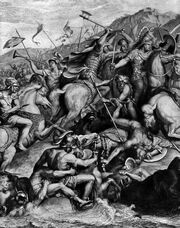
The Carantia-Hispalian War
The period is called early because in the west of the region co-existed numerous state hometowns Selloi and Mauryan who traded between them and fought numerous conflicts either by trade disputes as military superiority, either by the many conflicts as evidence little archaeological that can give scientific certainty of the events during the early age of the Selloi, the city states fought against each other for hegemony of the region, this conflict, between myth and reality is called the great war between the city of Mauryans called Carantia and the Selloi city called Hispales, this conflict decides the destiny of the ethnic protagonism in the peninsula and the future of the Ruthenian culture, when the Hispalians emerged victorious after 20 years of war where the city of Hispales.
The victory of Hispales brought hegemony in the region of the Selloi culture and expelled most of the Maurians to the north, where they form another city-states, the most known of the north Maurian city-states is Arcadia, who prospered as a grand maurian city state and becomes the capital of a future Principate recognized 600 years later, forming his own history in the peninsula.
Hellena of Hispales[]
Hellena is remembered as the unify all the Selloi tribes into one great culture, and Hellena was a queen and leader of the city of Hispales discovered the Orthodox canons and stated that the citizens were followers of the Hispales religion, Hispales soon becomes the most important Doukelias of the Peninsula thanks to his teachings and his work unify the other tribes, all the Selloi becomes Hispales citizens and Orthodox, Hellena becomes the Mother of the Selloi and the foreigners called "Hellenes" to the Selloi people.
Soon after his death in 480 AM, the tribes around Hispales start fighting for the Hellena Legacy in the city, in 388, forty eight years later his death, Hispales falls against pagans tribes and revolutionaries, the Archaic History ends with the destruction of Hispales and the reconstruction of the Selloi cities as Orthodox cities and the foundation of Beretea near Hispales.
After the death of Hellena in 450 AM, was numerous Sellooi doukelias fighting each other for the hegemony and legacy of Hispales, defeating and destroying the city during a sack in 480 AM, after thar little is known about Ruthene and Hellene history, almost all the sources was destroyed during the sacks and the later migrations of the Korimis Tribes and Sarbian Migrations
The Dark Period[]
The Dark Period beginning with the Fall of Hispales (480 AM) and finish with the proclamation of St. Stephanos as the first king of Kormenia (1000 AM), during his time the Peninsula suffered two great migrations and almost all the written local sources was forgotten by the continous sacks of Sarbians and Korimis, the Korimis becomes the predominant people of the peninsula, founding the Kingdom of Kormenia
The decline of the various city states brought two important events for the Ruthenian history, The creation of the Rothoi League to counteract the constant foreign invasions, the Korimi conquest of the Rothinoi Peninsula and the establishment of the principate of Kormenia and Slavinia respectively.
Sarbian Migrations[]
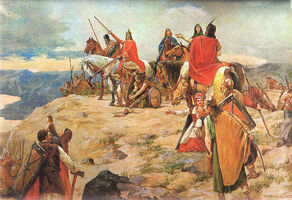
Living of the first Sarbians in the Peninsula
The Sarbians (spelled variously in Latin and Selloi) were a northern tribe who migrated first came to the Peninsula, probably expulsed by unknown tribes and they were part of the series of raids and incursions carried out by Sarbian groups during the Dark Period. They settled and they mixed with the local population in the ancient city-states, especially in Terepesos where gradually occupied territories, later created numerous small states centered throughout Terepesos and the Selloi had different religious and linguistic conflicts, Ruled by Miloslav created a strong state in the west part of the peninsula, conquering the neighbouring Selloi territories around Cispatria and Megerea.
The son of Miloslav, Zdeslav , became Orthodox thanks to Selloi teachings and the working of the Patriarchy to Terepesos and the evangelization of St. Theodoros (brother of the Doux Zdeslav) between the Sarbian people, the first saint of the Sarbs turned evangelized the Sarbians, achieved a greater understanding between the Sarbs and Selloi thanks to the religion, but the sarbians used the Latin language to communicate his ecclesiastical matters in diversal councils, Sarbs gradually began to marry into the Selloi acquiring through their customs and religion achieved a harmonious coexistence, the Sarbians arrived and established various linguistic contacts and for generations settled in the area south of the peninsula, bordering the each region and bigger Arcadia.
Zdeslav brother, Bratislav, became know as St. Theodoros after his death, unified their missionary work and got a better understanding among Selloi and Sarbian
Formation of Rothoi League[]
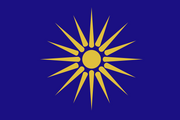
The flag of the Rothoi League adopted by Rúmina of Beretea in the formation of the league
After the Sarbian invasions between 500 and 600 AM. Rúmina, the doux of Beretea called for a alliance between various city-states unified by the Orthodox Church, and expanded throughout the peninsula, Rúmina called the union of cities in mutual defense against any threat case against pagan freedom and Rúmina signed an oath before God at the Cathedral of St. Hellena in their capital and called all the leaders of the Selloi cities to do the same, almost all cities were united and formed the league.
Rúmina takes the Veginia Sun as the sign of the League, by Selloi thought that the sun represents God and then there was never a quorum to take another symbol (other cities as Carantia still was considered heathen and heretics in the eyes of Beretea) and adopted the sun as symbol where each light is one of Selloi cities
The members of the Alliance is sworn to protect the lifestyle of the Selloi and their religion, which was in his eyes "the only thing that united" and according to the words of Rúmina "only religion Unify the Selloi" and under that oath were created the Rothoi League. seeing the constant foreign invasions ended with diversal Selloi city states on the borders, the oath came the 650 and lasted almost 400 years, the league was considered a Confederate own state in various cities that functioned independently and under common enemies during wartime.
Shortly after its inception, Beretea began to use the League's navy for its expand his influence. This behavior frequently led to conflict between Beretea and the less powerful members of the League. By 730 AM, after succesive invasions, the Korimis Tribes attacked the Rothinoi penninsula and after a century of invasions the league was forced to dissolve and the Selloi was integrated to the Korimi culture in 895 AM. the few independent Selloi cities were small islands to the south which were conquered by Korimi a century later
The Korimi and Selloi culture gradually unified thanks to the fascination of the Korimis by culture and Hellenic language, becoming the "heirs" in fact the Selloi in terms of politics, language and culture, the Selloi gradually educated to invaders and eventually joined with korimis, becoming one people, after 300 years and the coronation church that protected both the Selloi was sworn by St. Stephanos a son of Korimi and Selloi, unify the both people.with the passing of the years, took korimis customs of the Selloi and the Selloi term and Kormenian and were totally synonyms.
Korimis Conquest[]
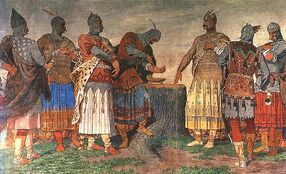
The blood oath in Porcuna
The Kormenian conquest started in the context of a "late or 'small' migration of peoples". Contemporary sources attest that the Kormenians crossed the Kalakea river following a joint attack in 894 or 895 by the Colomis and Beretians against them. They first took control over the lowlands east of the river Danuba and attacked and occupied Terepesos (the region to the west of the river) in 900. They exploited internal conflicts in the western city states and annihilated this state sometime between 902 and 906.
The Korimis strengthened their control over the Peninsula by defeating a joint Selloi army in a battle fought at Lake Carmelia on July 4, 907. They launched a series of plundering raids between 899 and 955 and also targeted the City states of Mauria in 971. However, they gradually settled in the peninsula and established a orthodox monarchy, the Kingdom of Kormenia around 1000.
The Korimis settled in the lowlands of the Rothinoi peninsula along the rivers Danuba, Garona and their tributaries, where they could continue their semi-nomadic lifestyle. As an immediate consequence, their arrival provoque the collapse of the Rothoi League and other city states tributaries to the Korimis, Beretea and other allies becomes subjects of the Kormenians during 150 years, The Kormenian leaders decided that their traditional lifestyle, partly based on plundering raids against sedentary peoples, could not be continued. The defeats at Arcadia and the adoption of the customs and religion of the Selloi accelerated the Korimis' adoption of a sedentary way of life. This process culminated in the coronation of the head of the Kormenians, Stellios the first king of Kormenia in 1000 and 1001.
Kormenian Period[]
The Kormenian Age or the Age of Kormenia is separated into two periods: one is the Early Period or the Kingdom Period (1000-1901), that begins with the crowning of St. Stephanos and the creation of the state of Kormenia and ends 900 years after the death of Menelaos IV and the succession crisis caused by the lack of an heir, assuming Emmanuel I after the Battle of Dadgori.
And the Late Period or the Imperial Period (1901-2588) starting from the coronation of Emmanuel devoting himself as emperor of Kormenia until the fall of Beretea and destruction of the Kormenian state under the Parsians after a war that lasted nearly 300 years (2281-2588)
The Formation of Kormenian Kingdom[]
The Marriage between Stephanos and Adriana of Hispales mean the union between Selloi and Korimis people, Stephanos used the Orthodox Church and the privileged position of its ports for the expansion of the religion and his territories throughout the peninsula defeating his uncle and Markos Quantias in the battle of Vlaechaum, Stephanos, achieving the unification and modernize all the tribes of the region, he finally resisting the conversion was Eupeithes of Tarafia, the last pagan Selloi and create the Kingdom of Kormenia in the year of his coronation in 1000 AM
the Korimis brought not only completely renovated customs, but fully integrating a culture all conflicting customs of various ethnic groups of the region, in addition to the language and culture brought the Orthodox religion, this religion became a mainstay in Korimi society culturally and religiously unifying all peoples conquered by the Kormenians and making it more harmonious its annexation, the Korimis brought a renewed culture and a sense of national unity that only the Selloi experienced before with St. Hellena considering the descendants of the Korimis conquerors as "Hellenes", the first Kormenian conqueror and support the integration of selloi in Beretea was Álmos, considered the father of the Kormenian state and founder of the Almodian dynasty.
Early Period[]
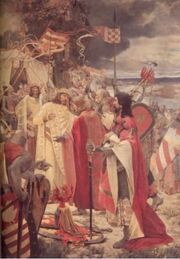
Unification of Kormenia and Slavinia in 1101
The Almodian dynasty was known as the first kings of Kormenia and the first saints of the Orthodox Church, St. Stephanos was the first king of the new Korimi State and the first kingdom of the Selloi people, Saint Stephanos himself understood the meaning the Korimi as the "The unification of all tribes in one objetive, one god, one autorithy chosen by god himself" the first capital was Beretea and founded the first or better know as the "Dinasty of the Saints" Saint Stephanos soon becomes a saint to the orthodox church for his contribution of the church history.
The Descendants of Stephanos have a prosperous kingdom unify thanks to the church, but the new Korimis was attacked both by old enemies as pagan tribes as rebelds they did not want to belong to the Korimi administration, but soon the Kingdom make peace or annex them thanks to the evangelization or the cultural similarities, conquest and unification through the evangelization of various city states and their powerful rivals trade were key tools to address and expand the influence of the new Korimi people, Changes were also observed in the internal structure of the Kingdom which was dictated by both external and internal conditions, the Kormenian kingdom soon reached half of the Ruthenian Peninsula. and later Phillipos of Kormenia, annex Slavinia after the Battle of Orotal Mountain annexing the orthodox territories of Slavinia and Kormenia, becoming "King of Kormenia and Slavinia" since Phillipos, the kings of Kormenia ruled both countries as one, merging both territories, culture and customs.
Since 1120 the government of Kormenia have numerous events, like the unsuccessful wars with the Principality of Arcadia and other neighboring states characterized the reign of Sebastiano I who succeeded his father in 1100. Also the earliest mention of the new King from the same year is connected to his first war. They lived in scattered communities along the borders, but in the next century their groups were moved to the easternmost regions of Massalia. Sebastiano I died childless in 1120. Under the blind Sebastiano II, the kingdom was administered by his queen, Helena of Rotea who annihilated his opposition by ordering its leaders' massacre. Indeed, Boris Kalamanos, an alleged son of King Phillipos received no internal support against the king.
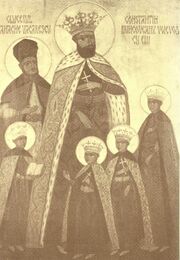
When Menelaos I died childless in 1218, his brother, Apolonios ascended the throne. He reconquered the western region. A contemporary list shows that more than 50 percent of his revenues derived from the annual renewal of the silver currency, and from tolls, ferries and markets. According to the list, his total income was the equivalent of 32 tonnes of silver per year, but this number is clearly exaggerated. The historian Nikolaos Choniates suggests an annual income of 23 tonnes of silver, but even this sum would have been the double of contemporary Aquitanian monarchs' yearly income.
Apolonios emphasized the importance of making records on judicial proceedings, which substantiates later Kormenian chronicles' report on his order of the obligatory use of written petitions. Landowners also started to put into writing their transactions, which led to the appearance of the so-called "places of authentication", that is cathedral chapters and monasteries authorized to issue deeds. Their emergence also attests to the employment of an educated staff. Indeed, students from the kingdom studied at the universities of foreign nations since 1200.
Further aspects of the 12th-century Selloi culture can also be detected in Apolonios kingdom. His palace at Beretea was built in the early Selloi style.
The Invasion of Comans occupied and thoroughly plundered the territories east of the river Danuba. They crossed the river when it was frozen in early 1542. the kingdom did not cease to exist, since the invaders could not take a number of fortresses. Furthermore, Batu Khan ordered the withdrawal of all his troops when he was informed of the death of the Great Khan in 1550.
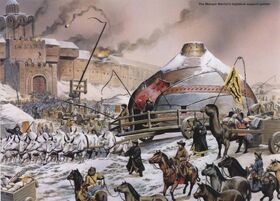
The Coman Invasion
The invasion and the famine following it had catastrophic demographic consequences. At least 15 percent of the population died or disappeared. Transcontinental trading routes disintegrated, causing the decline of Beretea, Massalia and other traditional centers of commerce. Local Muslim communities ceased to exist, showing that they suffered especially heavy losses, after 200 years the kingdom was able to recover.
Manuel II (1650-1683) abandoned his attempts to recover former crown lands after the Coman withdrawal. Instead, he granted large estates to his supporters, and urged them to construct stone-and-mortar castles. He initiated a new wave of colonization which resulted in the arrival of a number of Selloi, Mauryans, Parsians, Rúmis and Sarbians. The king reinvited the Selloi people settling along the Danuba. A group of Alans, the ancestors of the Jassic people seems to have settled in the kingdom around the same time.
New villages appeared which consisted of timber houses built side by side in equal parcels of lands. For instance, the settlement network of the so far scarcely inhabited forests of the Western Ruthenia began to develop under Manuel II. Huts disappeared and new rural houses consisting of a living room, a kitchen and a pantry were built. The most advanced agricultural techniques, including asymmetric heavy ploughs, also spread in the whole kingdom.
Internal migration was likewise instrumental in the development of the new domains emerging in former royal lands. The new landholders granted personal freedom and more favorable financial conditions to those who arrived in their estates, which also enabled the peasants who decided not to move to improve their position. Manuel II granted privileges to more than a dozen of towns, including the border villages.
The wealthiest landholders forced the lesser nobles to join their retinue which increased their power. One of the barons, Nicephoros Doukas attack the royal landholding of Kormenia, causing the crowning of Tivadar, 3 years later he died because a poisoning of his brother Pavlos I (1615-1650) this provoque a series of civil wars between brothers and noble families during 300 years.
When Menelaos IV was murdered in 1901, the Patriarchate declared the kingdom a vacant fief and granted it to his sister's son, Alexios of Carantia However, the majority of the Kormenian lords supported Emmanuel, the grandson of Arsenios (1842-1860), although his father's legitimacy was dubious. He was the first monarch to take an oath on respecting the liberties of the Church and the nobility before his coronation. He regularly convoked the prelates, the lords and the noblemen's representatives to assemblies known as Diets, which started to develop into a legislative body.
Late Period[]
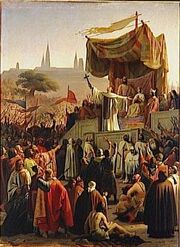
Proclamation of Emmanuel as Emperor
Kormenia was installed as a Empire after the Battle of Dadgori between Kormenia and Arcadia, when Emmanuel I defeat the Arcadian army and proclaimed himself as the first Emperor of the Korimis, being the significance of the emperor as the "unification of all orthodox people in one sole rule guided by god" and the emperor was choosen and blessed by the patriarch to rule the faithful people of the peninsula, Emmanuel was the first Emperor of Kormenia and between 1901 and 2008 the Kastarti dynasty ruled the Empire firmly and many advances in the respect between cultures that lived in the region, so the historians say the "golden age" of Kormenia lived between 1900 and 2000.
The Descents of Emmanuel have a prosperous empire unify thanks to the church and numerous civil reforms, but the new Korims was attacked both by old enemies as pagan tribes as rebelds they did not want to belong to the Korims administration, the good emperor can annex the enemies and make good agreements between the noble houses.
Changes were also observed in the internal structure of the Empire which was dictated by both external and internal conditions. The predominance of the small free farmers, the expansion of the military estates and the development of the system of Komietes, brought to completion developments that had started in the previous period. Changes were noted also in the sector of administration: the administration and society had become immiscibly Selloi, while the restoration of Orthodoxy after the numerous pagans movements, allowed the successful resumption of missionary action among neighboring peoples and their placement within the sphere of Kormenian cultural influence. During this period the state was geographically reduced and economically damaged, since it lost wealth-producing regions; however, it obtained greater lingual, dogmatic and cultural homogeneity.
The growth of the towns attracted people of other continents, specially from the east, when the subjects of the recently installed Sultanate of Parsia make major trade agreements with the Kormenian coastal cities, and this interest in trade appears to have further increased economic prosperity in Kormenian towns. Certainly, the Persians and others were active traders in the ports of Eridana, and they made a living out of shipping goods between various ports in the continent.
Golden Age[]
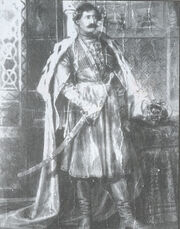
Manuel III, last Emperor of Kastarti dynasty
The 20th and 21th centuries are said to be the Golden Age of Selloi art in Kormenia. Many of the most important Kormenian churches in and around Beretea and other important cities, for example, were built during these two centuries, and this reflects the growth of urbanisation in Kormenia during this period. There was also a revival in the mosaic art with artists showing great interest in depicting natural landscapes with wild animals and scenes from the hunt. Mosaics became more realistic and vivid, with an increased emphasis on depicting three-dimensional forms. With its love of luxury and passion for color, the art of this age delighted in the production of masterpieces that spread the fame of the kingdom throughout the continent.
Beautiful silks from the work-shops of Beretea also portrayed in dazzling color animals—lions, elephants, eagles, and griffins—confronting each other, or representing Emperors gorgeously arrayed on horseback or engaged in the chase. The eyes of many patrons were attracted and the economy of Kormenia grew. In the provinces, regional schools of Architecture began producing many distinctive styles that drew on a range of cultural influences. All this suggests that there was an increased demand for art, with more people having access to the necessary wealth to commission and pay for such work.
Yet the marvelous expansion of Selloi art during this period, one of the most remarkable facts in the history of the Kormenia, did not stop there. From the tenth to the 22th century the empire was the main source of inspiration for the other minor countries. By their style, arrangement, and iconography the mosaics of their eclesiastical style.
The last Emperor of the Kastarti was Manuel III (2002-2008) who died young by measles, and his death bring the fear of another forgotten civil war, but rapidly was solved by his cousin Andronikos Sagona, who proclaimed by the Patriarch as Andronikos VI
Decline[]
Manuel V (2215-2232) also know as "The Great" thanks to his rule and conquest of the southern islands and the success of the protection of Agios against pirates, in his northern borders, the Parsians conquest Thabasion and blocked the Kormenian merchant navies, the constant raids of Parsians and the menace of the new religious schism, Manuel, declared a "great war" agains Parsia in 2212, called the conflict as the Kormenian-Parsian War That war would mark the future of the empire and the history of the peninsula for the past 900 years. This war ended in 2588, 300 years later after multiple warfare which caused a massive diaspora of Selloi people and gradual weakening of the structures of the Kormenian state and the reduction of its land from Parsian invasions
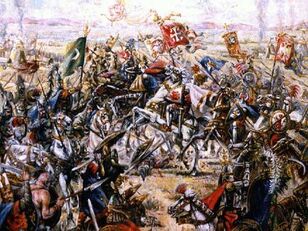
The Battle of Kollonia meant the death of Emperor Demetrios I and final decline of the empire
During the Great war, The decline of the reigning dynasty was evident, Emperor Emmanuel III was considered a drunken playboy who delegated the imperial administration to its protected and general fighting in the border needed imperial support, one of his generals, Andreas, was revealed to the imperial power ecclesiastical permission and made a coup to overthrow emmanuel, the emperor was exiled to the north and was never heard from him, and was crowned as Andreas III
Andreas III Gifted with a fine physique and great personal courage, unconditionally devoted to a military career. He struggled to restore by force of arms the predominance of Kormenia in all the borders, assembled his army at the military base Lopadion and set out on a punitive expedition against Farvardin the Sultan of Parsia, who had been repeatedly violating the frontiers of the Empire in western borders. There was no attempt at a systematic conquest of territory, but Andreas's army defeated the Parsians at Acrones, before capturing and destroying the fortified town of Philomelion, removing its remaining Christian population. The Kormenian forces reached Farvarhin's capital, Konya, and ravaged the area around the city, but could not assault its walls, securing the borders and a brief peace between the countries.
His grandson, Demetrios I died during the Battle of Kollonia defending the city and the defeat of the Kormenian Army, after his death, the house of Milessinos, a cadet branch of the Mavrodoukas take the power.
Fall[]
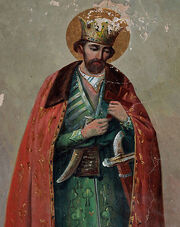
Thomas II, Last Kormenian Emperor
The Angeloi dynasty failed to stop the invasions of the Parsians by the Sultanate of Parsia, the successful uprising and resurrection of the Parsians
A combination of incompetence and bitter infighting among the elite saw Kormenia permanently lose her financial capability and substantial military power; her previous policies of openness with foreigners, followed with the sudden massacre of parsians under the last Angelos emperor, had preceded the rule of the Angeloil making enemies among foreigner states. The weakening of the empire under the Angeloi dynasty invited the end of the Empire in 2588 under the rule of Thomas II.
The war and the Angeloi decandence was so long that wore the troops and Kormenian society to the point that they lost faith both in government and in his own empire, diasporas and numerous migrations weakened the flagging position and Persians locks precluded the arrival of new inhabitants were formed, the situation was to the point that the last Emperor of Kormenia, Thomas II said "Kormenia nothing left, only history and its treasures, people no longer believe in this empire"
In 2588 ended with the fall and destruction of Beretea and enslavement of the all Selloi people, the period of Great War decisively influenced the Imperial internal development, as elements of feudality entered aspects of Ruthene life.
Enslavement Period[]
The Parsian or Period of Enslavement begins after the Fall of Beretea in 2588 and ends in the Battle of Ostambal in 3216, other intelectuals say the Enslavement ends when the Enosis begins and the revolution war marks the collapse of the Parsian Empire.
When the Parsian arrived, two Selloi migrations occurred. The first migration entailed the Selloi intelligentsia migrating to west of the region and other migration in the long mountains in the south of the continent.
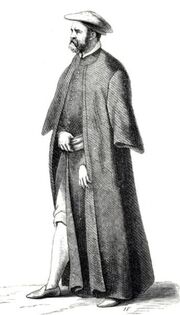
Selloi Merchant under Parsian rule
The Selloi living in the plains during Parsian domination were either Christians who dealt with the burdens of foreign rule or Crypto-Christians (Selloi Muslims who were secret practitioners of the Orthodox faith). Some Selloi became Crypto-Christians to avoid heavy taxes and at the same time express their identity by maintaining their ties to the Orthodox Church. However, Selloi who converted to Islam and were not Crypto-Christians were deemed Turks in the eyes of Orthodox Selloi, even if they didn't adopt Persian language.
Parsian rule of the provinces was characterized by two main functions. The local administrators within the provinces were to maintain a military establishment and to collect taxes. The military establishment was feudal in character. The Sultan's cavalry was entirely Persian and were allotted land, either large allotments or small allotments based on the rank of the individual cavalryman. All non-Muslims were forbidden to ride a horse which made traveling more difficult. The Parsians divided Ruma into six sanjaks, each ruled by a Sanjakbey accountable to the Sultan, who established his capital in Ostambal in 2590.
The conquered land was parceled out to Parsian nobles, who held it as feudal fiefs (timars and ziamets) directly under the Sultan's authority, all the Ruman nobility was abolished, maintain only their "empty and dishonorable titles" many noble Selloi fled to remote islands or even south, taking advantage of the installation of Kingdom of Mauria as a tributary state of the Persians to keep not only his honor but his freedom, others stayed in their homelands, keeping their "empty titles" seeing themselves forced to sell in order to maintain a decent life. The Ruman land could not be sold or inherited, but reverted to the Sultan's possession when the fief-holder died. During their life-times, these Parsian nobles, who were generally cavalrymen in the Sultan's cavalry, lived well on the proceeds of their estates with the land of the estate being tilled largely by peasants.
The economic situation of the majority of Ruthene lands deteriorated heavily during the Parsian era of the country. Life became ruralized and militarized. Heavy burdens of taxation were placed on the Orthodox population, and many Selloi were reduced to subsistence farming whereas during prior eras the region had been heavily developed and urbanized. The exception to this rule was in Tortossa and some minor islands, where many Selloi lived in prosperity. The Selloi heavily resented the declining economic situation in their country during the Parsian era.
After about 3000, the Parsians resorted to military rule in parts of Ruthenia, which provoked further resistance, and also led to economic dislocation and accelerated population decline. Parsian landholdings, previously fiefs held directly from the Sultan, became hereditary estates (chifliks), which could be sold or bequeathed to heirs. The new class of Parsian landlords reduced the hitherto free Selloi farmers to serfdom, leading to depopulation of the plains, and to the flight of many people to the mountains, in order to escape poverty.
The Selloi paid a land tax and a heavy tax on trade, the latter taking advantage of the wealthy Selloi to fill the state coffers. Selloi, like other Christians, were also made to pay the jizya, or Islamic poll-tax which all non-Muslims in the empire were forced to pay instead of the Zakat that Muslims must pay as part of the 5 pillars of Islam. Failure to pay the jizya could result in the pledge of protection of the Christian's life and property becoming void, facing the alternatives of conversion; enslavement or death.
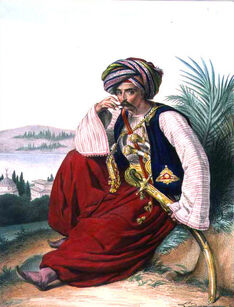
a Selloi Muslim
Like in the rest of the Parsian empire, Selloi had to carry a receipt certifying their payment of jizya at all times or be subject to imprisonment. Most Selloi did not have to serve in the Sultan's army, but the young boys that were taken away and converted to Islam were made to serve in the Parsian military. In addition, girls were taken in order to serve as odalisques in harems.
These practices are called the "tribute of children" (devshirmeh) (in Hellenic: παιδομάζωμα paidomazoma, meaning "child gathering"), whereby every Christian community was required to give one son in five to be raised as a Muslim and enrolled in the corps of the military. There was much resistance, for example, Hellenic folklore tells of mothers crippling their sons to avoid their abduction. Nevertheless, entrance into the corps (accompanied by conversion to Islam) offered Selloi boys the opportunity to advance as high as governor or even Grand Vizier. One prominent example is Karlani Ibrahim Pasha, who was born the son of a Selloi fisherman from Parga and became one of the most trusted advisors of Sultan Suleiman and field general and statesman with his own palace. Recruits were in a some cases gained through voluntarily accessions, as some parents were often eager to have their children enroll in the Janissary service that ensured them a successful career and comfort.
Opposition of the Selloi populace to taxing or paidomazoma resulted in grave consequences. For example, in 2905 an Parsian official was sent from Naoussa to Bresia in search and conscript new childs and was killed by Selloi rebels who resisted the burden of the devshirmeh. The rebels were subsequently beheaded and their severed heads were displayed in the city of Bresia. In some cases, it was greatly feared as Selloi families would often have to relinquish their own sons who would convert and return later as their oppressors. In other cases, the families bribed the officers to ensure that their children got a better life as a government officer.
Orthodoxy during the Enslavement[]
The Ecumenical Patriarchate was banned from the Parsian Empire and what's left of the institution sought refuge in the islands of Mount Agios in 3171 after the interregnum, the Sultan regarded the Ecumenical Patriarch of the Orthodox Church as the leader of all Orthodox, Selloi or not, within the empire. The Patriarch was accountable to the Sultan for the good behavior of the Orthodox population, and in exchange he was given wide powers over the Orthodox communities, including the non-Selloi peoples. The Patriarch controlled the courts and the schools, as well as the Church, throughout the Selloi communities of the empire.
This made Orthodox priests, together with the local magnates, called Meneriotes, the effective rulers of Selloi towns and cities. Some Selloi towns, such as Tortossa (main Selloi community in Parsian Period) and Menelogion, retained municipal self-government, while others were put under Parsian governors. Several areas, such as the Mani Peninsula in the Peloponnese, and parts of Skoures (Sfakia) and Salonia, remained virtually independent. During the frequent Parsian wars, The Orthodox Church assisted greatly in the preservation of the Hellene heritage, and during the 29th century, adherence to the Orthodox faith became increasingly a mark of Hellene nationality.
As a rule, the Parsians did not require the Selloi to become Muslims, although many did so on a superficial level in order to avert the socioeconomic hardships of Parsian rule or because of the alleged corruption of the Selloi clergy. The regions of old Ruma which had the largest concentrations of Parsian-Selloi Muslims were Bresia. Under the millet logic, Selloi Muslims, despite often retaining elements of their Selloi culture and language, were classified simply as "Muslim", although most Orthodox Christians deemed them to have "turned-Turk" and therefore saw them as traitors to their original ethno-religious communities.
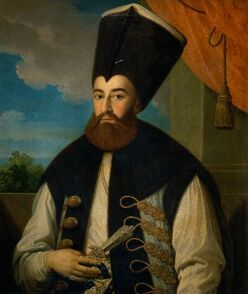
John Tzelepes Komnenos, a Selloi-Parsian Muslim and Grand Vizir of the Sultan
Some Selloi either became New Martyrs, such as Saint Efraim the Neo-Martyr or Saint Demetrios the Neo-martyr while others became Crypto-Christians (Selloi Muslims who were secret practitioners of the Orthodox faith) in order to avoid heavy taxes and at the same time express their identity by maintaining their secret ties to the Orthodox Church. Crypto-Christians officially ran the risk of being killed if they were caught practicing a non-Muslim religion once they converted to Islam. There were also instances of Selloi from theocratic or Kormenian nobility embracing Islam such as John Tzelepes Komnenos and Misac Palaeologos Pasha.
Ruthene historians noted the liberal and generous nature of Parsian Sultans after the Interregnum. Mesud II, according to a Ruthenian historian, freely admitted Christians into his society while Nazif set out reforms of abuses that was prevalent under Selloi rulers. Persecutions of orthodoxy did nevertheless take place under the reign of Tokdemir (3088-3101), known as Tokdemir the Grim, who attempted to stamp out Christianity from the Parsian Empire. Tokedmir ordered the confiscation of all Orthodox churches, and while this order was later rescinded, Christians were heavily persecuted during his era.
Decline[]
Main Article: Meteriotes
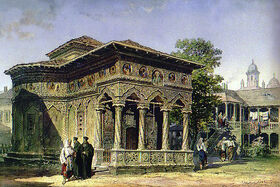
The Church of Menerea in now Auronopolis
After the civil war in 3171, The Parsian Empire entered a long decline both militarily each other and internally, leading to an increase in corruption, repression and inefficiency. This provoked discontent which led to disorders and occasionally rebellions. As more areas drifted out of Parsian control, the Parsians resorted to military rule in parts of old Ruthenia. This only provoked further resistance. Moreover, it led to economic dislocation, as well as accelerated population decline.
Another sign of decline was that Parsian landholdings, previously fiefs held directly from the Sultan, became hereditary estates (chifliks), which could be sold or bequeathed to heirs. The new class of Parsian landlords reduced the hitherto free Selloi peasants to serfdom, leading to further poverty and depopulation in the plains. Tortossa was on its most part a run-down village, its peasant Selloi population extremely poor and isolated, not allowed near the Acropolis where the more wealthy Persian were settled.
On the other hand, the position of educated and privileged Selloi within the Parsian Empire improved greatly in the 27th and 28th centuries. As the empire became more settled, and began to feel its increasing backwardness in relation to the Eridanan powers, it increasingly recruited Selloi who had the kind of administrative, technical and financial skills which the Parsian lacked, these Selloi was called Meteriotes, because these families was settled in the Meterea, a district south of Auronopolis, near the church of Meterea.
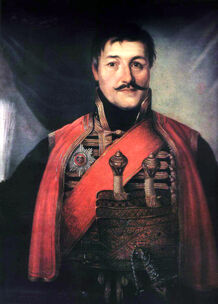
Michael Auronopoulos was the first Ruthenian revolutionary and Martyr of the Empire
From the late 3100 the Selloi began to fill some of the highest and most important offices of the Parsian state. The Meteriotes became increasingly powerful. Their travels to West as merchants or diplomats brought them into contact with advanced ideas of liberalism and imperialism, and it was among the Meteriotes that the modern Hellene nationalist movement was born under the arm of various Meteriotes and other Selloi, the first Meteriote was Michael Auronopoulos called by the Selloi as the Prostatef̱tikós ton Ellínon (First liberator of the Hellenes), called to all rebeld Meteriotes and founded the seeds of the Enosis and called to the "Patriotism all now slaves to seek a new future as Hellenes"
The revolution begins with isolated but strong attempts of regaining independence, many revolts led by Auronopoulos own army, many bands and Maurian-Hellene mercenaries around the region unite force against the Parsians for the Hellenes Liberty, Auronopulos falls in 3176 in the Battle of Koronia and Parsia gains subjugate the Hellene revolution, the death of Auronopoulos fell deep into the spirit of the Selloi, who saw the courage of the noble a glimmer of hope that had been forgotten after centuries of slavery and oppression had fallen revolutionary, but his figure became a martyr, many clerics and metropolitan secretly praised him as a true saint and many young Selloi of all social classes grew or were under his command, despite heavy propaganda measures to erase the Parsian Sultan, revolution Auronopoulos memory, his death ended one spark turned on Enosis
The Enosis[]
Main Article: The Enosis
The new Ruthenian aristocracy and Selloi prominent families (called as Meteriotes for the Parsians) gained considerable control over Parsian foreign policy and eventually over the bureaucracy as a whole. The Martyrdom was the inspiration of three Selloi/Ruthenian families: the Bagritioni, the Daskalaris and the Philaras, influenced by foreign ideas of imperialism and nationalism, they form part of The Enosis as an important center of mercantile and national affairs against Parsian rule, with the support of wealthy Selloi and ecclesiastical communities, they planned the independence and destruction of Parsian Empire, the formation of is own empire, a own orthodox empire governed by a basileus, chosen by god, a empire of Selloi, Maurian and any ethnicity enslaved by the Parsians, in the 3205 Konstantinos Daskalaris, prominent general in chief of the Parsian Empire is called leader of The Enosis and rapidly expanded and was soon able to recruit members of all Ruthenian world among all members of society.
The Ruthenian enosis soon took advantage of the death of Parsian Sultan to outbreak and planning the insurrection. The crucial meeting was held in Varasia (actual Euxodion) where chieftains and prelates from all over the peninsula assembled in 3206, the Patriarch Gennadios presented himself as a favoured of the Enosis and the tension of a possible failure begins, sporadic incidents against Parsians occurred, heralding the start of the uprising, the revolution was declared the 29 of June of 3206 by the patriarch himself raised the banner with the cross in the monastery of Agia Lavrea.
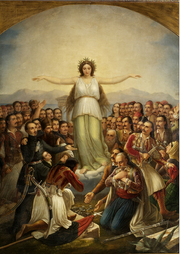
The Liberation of Ruthenia by Stefano Celsi
After 6 years of wars and near 50 years of conflicts for the liberation of the Ruthenes, a vital intervention of Sarbian tributes and the Meteriotes defeated the Parsians in numerous battles along the peninsula, the most recorded battles and decisive in the liberation of the Parsian was Navarena and Ostambal, where the Mauryans allied with the Parsians and the Sarbian navy of Altomanovic defeated the Mauryan navy in the gulf of Navarena, destroying almost all the Parsian fleet and Daskalaris finally reunited all in front of Ostambal, capital of Parsian Empire and fight against the empire for the liberation of the Ruthenes. Daskalaris leaded a offensive in the porte of Ostambal achieved after 3 weeks of siege the opening of the great gate of the city, After twenty years of war and the destruction of almost all the countryside, the Hellenes take Ostambal in April of 3215 by the entrance of Konstantinos Daskalaris and Manuel Notaras in a triunphal entry in the Parsian Capital.
After achieved the Parsian Muhammad Hady Faiz, the last governor and loyal to the sultan surrender and ejects completely from the country, with the victory of the revolutionaries and the definitively liberation of all Orthodox people of Ruthenia, victory of the revolutionaries was declared on 23 May 3216 with the victory of the revolutionaries and the definitively liberation of all Ruthenia and the collapse of Parsian Empire.
The consequences of the revolution bring the exile or domination of Parsian people and the birth of Ruthenian Empire, the home of Selloi and all orthodox people, as a whole and new state in the Peninsula. The first Ruthene leader was Konstantinos Daskalaris himself, named Basileus by the Patriarch Gennadios III elected as protector of the Ruthenes, since then Konstantinos is named as Konstantinos I and acclaimed by all the new Ruthene Aristocracy, becomes a Imperial Autocracy with Konstantinos as its founder
| ||||||||||||||||||||||||||||||||||||


